
A Lancer vs. a Bayonet Fencer: Victorian mixed-weapons combat

The phrase "Assault at (or 'of') Arms" was coined in the early 19th century to describe displays of skill-at-arms performed as public entertainment. Many of these events combined competition with showmanship; some were strictly competitive and others pure ballyhoo. All were influential in the development of Victorian combat sports, self-defence systems and military close-quarter battle techniques.
The first part of this article summarises the history and variety of the Assault at Arms, and the second part examines the tradition through the eyes of Victorian newspaper and magazine illustrators, who recorded many of these events in woodcut prints.
PART ONE

Astley's Amphitheatre
In 1777 former cavalryman and riding school owner Philip Astley opened "Astley's Amphitheatre" as an enclosed hippodrome for horse-races, with side-shows featuring clowns and acrobats. Realising the profit to be made from showmanship, Astley also developed a novel form of entertainment, the "hippodrama", in which entire plays were performed on horseback.
The Amphitheatre eventually became most renowned for its "Patriotic Spectaculars"; re-enactments of great battles, which were sometimes staged mere days after the actual events had taken place. The cast of 'The Battle of Waterloo' (1824) included real Waterloo veterans, and the Duke of Wellington was so pleased with it that he watched it twice. The Amphitheatre's cavernous arena space allowed re-enactments on a truly grand scale, featuring hundreds of actors, horses and cannons.
In 1871 the Amphitheatre was taken over by Lord Sanger, who shifted the emphasis from military to zoological spectacle.
Medievalism
"The boast of heraldry, the pomp of pow'r,
And all that beauty, all that wealth e'er gave,
Awaits alike th' inevitable hour,
The paths of glory lead but to the grave."
- Thomas Gray, Elegy, 1742
The 1740's saw a revival of interest in medieval life, beginning with a renewed enthusiasm for Gothic architecture and extending into literature, poetry, theatre, the fine arts, heraldry and studies of pedigree. In 1819, Sir Walter Scott published Ivanhoe, an epic novel of adventure and intrigue which was arguably the pinnacle of neo-Gothic literature. Ivanhoe was enormously popular and influenced a new generation towards romantic antiquarianism.
Perhaps the most spectacular manifestations of the Medievalist movement were the Grand Tournaments; historical pageants featuring elaborate ceremonies, costumes, sets, re-enactments of battles and jousting displays. Between 1750 and 1839 at least eighteen of these events were staged throughout Europe, the final being the Eglinton Tournament. This event stands as one of the most glorious and infamous follies of the 19th century.
Although a torrential downpour resulted in the "knights" and their mounts struggling through mud and sleet, all but invisible to the enormous crowd, Eglinton struck a sympathetic chord in the Victorian imagination. It served to whet the public's appetite for medieval martial spectacle, and this was partly appeased by a "Tournament and Siege" produced at Astley's Amphitheatre a few weeks later.
The Gymkhana
The earliest recorded military Assaults at Arms took place during the 1840's, possibly inspired by the Gymkhana competitions that had become popular among British troops serving in India.
The word "gymkhana" is a hybrid of the English "gym" and the Hindi "gend-khana", the latter meaning "a place where games are played". Thus, the Gymkhana was both the arena, which is the present-day connotation in Hindi, and the selection of sports played there, as in the modern English equestrian term. These contests combined traditional European and Indian feats of skill-at-arms, especially those useful in the training of cavalrymen. The inherent spectacle of managing lance and sword on horseback attracted large crowds, who enjoyed the competitions as entertainment.
The Physical Training Corps
The British Army Physical Training Corps was established in the 1860's, when Major Frederick Hammersley and twelve specially selected Non Commissioned Officers underwent a six month course of Physical Training (PT), under the direction of Mr Archibald McLaren, a civilian PT Instructor. This training course took place at Oxford University.
In 1862 an order was published for a gymnasium to be erected in every garrison, each with its officer and instructional staff. The building of gymnasia was later extended to include Regimental depots, until eighty had been erected. The first regulations for PT were published in 1865. These included a compilation of the great corpus of training exercises that had been developed by various regiments to date, and a variety of standardised training drills.
Given a body of professional instructors and an organised training system, the Physical Training Corps expanded upon the Gymkhana tradition, widening the scope of competitions to include hand-to-hand combat, gymnastics and tactical drills as well as mounted events.
Lead bars, broomsticks, apples and sheep
Upon their return to England in 1874, the Royal Madras Fusiliers staged a "Grand Assault at Arms" incorporating demonstrations of "broad and single stick fighting, mounted combat, bayonet and sword fencing, and gymnastics including the flying trapeze and vaulting". The highlight of the day's entertainment was a demonstration of prowess with the cavalry sabre by Staff Sergeant McKenzie. According to a local newspaper review;
These were marvellous. He cut bars of lead an inch and a half in thickness with a single blow as easily as he cut sheets of notepaper. He then cut an apple in slices on the head of a little boy, to the alarm of the ladies present, who were sadly afraid the little fellow would be made an inch shorter by a false blow. The skilful sergeant then cut an apple in two in a handkerchief without damaging the wrapper. This is an experiment that requires great practice. The whole of these sword feats were brought to a conclusion by a sheep being severed by a single blow - one of the best sword feats that we have ever had the pleasure of witnessing, and Sgt. McKenzie was loudly applauded as he left the gymnasium.In 1877 a Grand Military Assault of Arms demonstration, in aid of the 1st Norfolk Regiment Volunteers, was held at Chapel Field Drill Hall, Norwich. Amongst other items, the program was scheduled to feature:
A Sword Cutting Feat by Sgt. Major Clements, acknowledged to be the champion swordsman in the British Army: Cutting through 2 large sheep, with one stroke of the sword, a feat never before accomplished by any other swordsman.
A Sword Cutting Feat by Sgt. Instructor Haigh: He will cut a lemon on a man's head; also on a man's neck; severing a broom handle resting on 2 glasses of water without overturning the glasses or spilling the water; he will also cut an apple on a handkerchief without damage to the latter.
Cleaving the Turk's Head, an impression by Harry Payne, c. 1890
In 1878 Major Gildea, Major Hammersley's successor as Inspector of Gymnasia, presented an Assault-at-Arms at the Albert Hall. This event proved so successful that in the following year it was combined with the annual rifle display given by the Volunteer Forces on Wimbledon Common.
The Islington Tournament
On the 11th of June 1880, this notice was published in the Times Newspaper:
A Military Tournament and Assault-at-Arms is to be held from the 21st to 26th inst. at the Agricultural Hall, Islington. The Competitions, which are 53 in number, are to be open to all the regiments within range, and the profits are to be given in aid of the Funds of the Royal Cambridge Asylum for Soldiers' Widows. They include tilting at the ring, sword v. bayonet, lemon cutting, etc. This is the first time that a tournament of this kind has been organised. Among the patrons are the Prince of Wales, the Duke of Connaught, the Duke of Cambridge and Prince Edward of Saxe-Weimar. Major-General E.S. Burnaby, M.P., is the hon. sec.The Grand Military Tournament and Assault at Arms consisted entirely of competitions designed to encourage skill at arms for regular and volunteer members of the Army. The scale of this event dwarfed all previous efforts, as the Agricultural Hall could seat up to 10,000 spectators and the Tournament proceeded over six full days. The Duke of Cambridge had given his permission for the event to proceed, on condition that a sum of five hundred pounds should be paid to charity.
Unfortunately for the organisers, they had neglected to offer much in the way of advance advertising and the event itself received little press coverage, except for the "Officers' Day" (a Wednesday) when members of the Royal Family witnessed some of the events. As a result, the largest audience at any one performance did not exceed 3000 people, and the event ran to an embarrassing financial loss.
Undaunted, and perhaps in the spirit of the "gambler's throw", they staged a second Tournament in 1881. This attracted a similar lukewarm response from the press and public, but great interest from within the Army. Two hundred and twenty-eight officers and other ranks volunteered to participate, and most of them proposed to compete in six, seven or eight events, not including the various team trials. The second Tournament thus ran for two weeks, raising the total loss to the organisers to two thousand pounds, aside from the one thousand now owing to the Duke's nominated charities.

Learning from experience, the organising committee decided that the Tournament and Assault at Arms had to fulfil two related objectives. The first was to improve its participants' skill-at-arms through competition. Various inter-regimental Assaults at Arms were already being arranged in preparation for the next Grand Tournament, and all agreed that the annual event provided a great incentive.
The second objective was to benefit various military charities by offering the public an attractive entertainment. The 1880 and '81 Tournaments had consisted of long series of eliminating rounds in events such as "sword vs. bayonet", "lance vs. bayonet" and "tilting the ring", leading towards the championship finals. This served the first function admirably, but watching hundreds of contests was understandably rather numbing for a lay-audience. The organisers realised that in order to appeal to the general public, they needed to think in terms of show business.
Victorian Londoners enjoyed spectacle and novelty. Colossal exhibitions such as the World's Fair, Astley's Amphitheatre, and the extraordinary technical achievements of the great London play-houses were all proven draw-cards. The decision was made to limit the number of heats and competitors, returning to a more focussed and manageable one-week format; to hold the heats early in the day, saving the more exciting finals for the evening performances; and to intersperse the competitions with a variety of crowd-pleasing displays.
These included horseback wrestling, the Balaclava Melee (a mounted mock-brawl in which soldiers armed with singlesticks attempted to knock plumes from each other's helmets) and the Musical Ride, a mass display of synchronised horsemanship. This latter spectacle, in particular, took London by storm. The Agricultural Hall was packed for the week and the future of the Grand Tournament and Assault at Arms was assured.
In 1884 Queen Victoria became Patron and gave permission for the Royal Prefix to be added to the title. It was then renamed the "Royal Naval and Military Tournament", and eventually "The Royal Tournament". Over the subsequent decades the event gradually expanded to encompass all of the branches of the British Armed Services and then representatives from the various Colonial Armies. Many of the Colonial troops introduced novel display events as well as competing, thus adding even more colour and variety.
The standard competitions included:

Perhaps inspired by memories of Astley's "Patriotic Spectaculars", a wide variety of large-scale displays were created for the evening shows. There were demonstrations of cavalry tactics and horse charges, massed marching bands and heavy artillery manoeuvres staged as obstacle-course races. The Royal Navy offered synchronised gymnastic feats performed on ropes strung high above the arena, simulating ship's rigging. The climactic "Combined Displays" re-enacted famous sieges, rescues and skirmishes, featuring hundreds of soldiers and elaborate sets representing fortifications, mountain passes, and other exotic locations. The 1886 Tournament included a real river running through the amphitheatre. At its height, the spectacle of the Grand Tournament and Assault at Arms must almost have rivalled that of the Roman arena.

This annual pageant was maintained, other than during times of war, until 1999.
The Civilian Assault at Arms
In tandem with the military Tournaments, there arose a tradition of Assaults at Arms organised by civilian groups. Many of these were fund-raisers arranged by gymnasia and amateur sporting associations, drawing also upon the centuries-old tradition of gladiatorial stage combats, prize-fights and boxing exhibitions. A civilian Assault at Arms during the 1880's might include exhibitions of foil fencing, boxing according to the recently drafted Queensberry rules, a mixed-weapons display of bayonet against sabre, quarterstaff fencing, a cutting demonstration and a gymnastics routine. Borrowing from the military example, these events were often interspersed with martial music, processions and even lectures.
On February 23rd, 1892, the Oxford University Fencing Club presented an Assault of Arms intended to attract people to the comparatively new sport of fencing. The event was divided into three sections, each introduced by a selection of music played by members of the University orchestra.
The first section included bouts at foil and "duelling sword" or epee; the second featured a lecture by Fencing Club President Sir Frederick Pollock "explaining the transition of swordsmanship from the old English Sword and Buckler fight to Rapier and Dagger". This was illustrated by prominent fencing historians Egerton Castle and Captain Alfred Hutton, re-creating an "Elizabethan prize at verie many weapons" including the rapier and dagger, sword and buckler, and rapier and cloak. The third section featured more bouts at foil, sabre and duelling sword, and also mixed-weapon bouts at duelling sword against sabre. The finale was a bout demonstrating the Highland broadsword and target.
Captain Hutton was to note in his book Old Swordplay (1892):
There are those who affect to ridicule the study of obsolete weapons, alleging that it is of no practical use; everything, however, is useful to the Art of Fence which tends to create an interest in it, and certain is it that such contests as "Rapier and Dagger," Two-hand Sword," or "Broadsword and Handbuckler," are a very great embellishment to the somewhat monotonous proceedings of the ordinary "assault of arms."A similar eclecticism was displayed at the "Bartitsu Club Tournament" which was held at London's St. James' Hall on December 11th, 1901. This event, a typical Victorian Assault at Arms in all but name, included drill and bouting in Pierre Vigny's new system of self defence with a walking stick, a Jujitsu demonstration and a catch-as-catch can wrestling contest for a prize of fifty pounds. A review of this event was published in the January 1902 issue of "Sandow's Magazine".
The civilian Assaults at Arms, although not approaching the scale and ambition of the military versions, became quite fashionable and attracted large, appreciative audiences.
The Universities
Around the turn of the 20th century, Canadian and British University sports clubs began to hold their own Assaults at Arms, featuring an eclectic variety of combative sports and exercises. This allowed clubs to pool their resources and promote their activities with events such as bayonet drill, tug-of-war, boxing, wrestling and fencing. Although the tradition does not seem to have flourished in Britain, a streamlined Assault at Arms incorporating boxing, wrestling and fencing was maintained as an intercollegiate competition between Canadian universities until the 1940s.
PART 2
Thanks go to Postaprint for graciously allowing the use of scans from their online ILN prints database.
| Three panels.
Upper: an al fresco fencing display, possibly taking place in the Scottish Highlands going by the attire of the spectators in the foreground. Lower left: this is subtitled "Broadsword vs. Bayonet". This type of mixed-weapon contest was a popular form of military exercise. The broadsword fencer appears to be parrying the bayonetist's thrust with a high prime or seconde. Note the pile of weapons, helmets and padding visible in the foreground. A variety of broadsword and bayonets Lower right: an example of 19th century test cutting practice, employing a lever-armed quintain-like device. In this case, the swordsman appears to be cutting at a leg of lamb. His technique is not clear, but he may be about to reverse arms and perform a sweeping horizontal cut in carte. A modern test-cutting event |
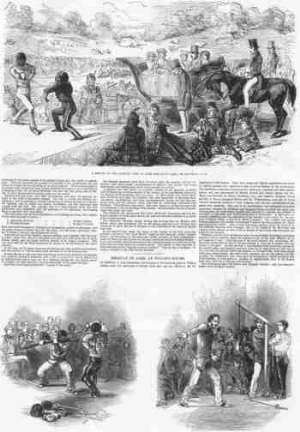
Untitled, Illustrated London News (30th June, 1849) |
| An Assault at Arms staged during a gymnastics and athletics meeting. The fencers do not appear to be wearing masks. |
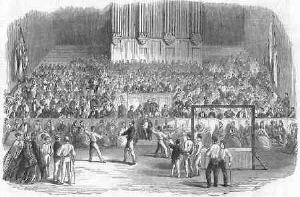 (30th April, 1864) |
| The Household Brigade was originally organised in 1660 under Charles II. It was composed of Household Cavalry together with regiments of Foot Guards, and regiments were entrusted with privileged task of guarding the Sovereign. In this demonstration a steel breastplate is about to be cleft, demonstrating the cutting power of the Brigade sabre. A modern test-cutting event |
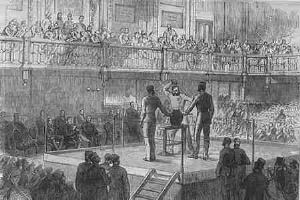
Assault at Arms: Household Brigadier Cleaving a Breastplate with a Sword |
| A variety of martial sports displayed at an athletics competition, including rope-climbing, pole-vaulting, fencing and boxing. Note the large Indian clubs leaning against the stage, suggesting that weight-lifting was also part of the day's events. A variety of articles on 19th century physical culture |
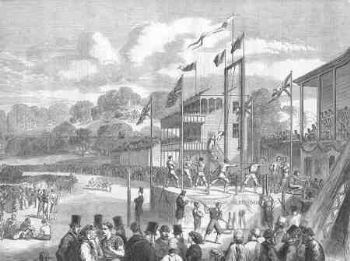
Athletics (12th August, 1865) |
| The sport of quarterstaffing enjoyed a revival in the
second half of the 19th century. Several instructional manuals
were published, including Thomas A. McCarthy's "Quarterstaff: A Practical
Manual" (W. Swan Sonnenschein & Co.,1883) and "Broadsword and Singlestick
w/ chapters on Quarterstaff, Bayonet, Cudgel, Shillelagh, Walking stick,
Umbrella and Other Weapons of Self Defence" by R.G. Allanson-Winn &
C. Phillipps-Wolley (London: 1890)
The players in the print above, who may be competing or simply demonstrating their sport, are clad in fencing uniforms, heavily padded fencing helmets, boxing gloves, leather aprons further secured by thongs about the thighs, and cricket leg pads worn on their left legs. The padded aprons are similar to those worn by Victorian butchers and street-cleaners, and provide a degree of groin and thigh protection. The staves employed in this sporting version of quarterstaff play were relatively lightweight lengths of ash or bamboo. The weapons were actively used in both quarter- and half-staff grips. Bouts commenced with a formal salute and proceeded through a vigorous engagement of attacks and parries. Some rules allowed thrusting as well as striking attacks, but all banned wrestling and grappling. Bouts were typically fought to a "best-of" points system. The Boy Scout movement enthusiastically adopted quarterstaff play, and there is anecdotal evidence to suggest that this sport, and/or the associated drill, was still practised by some Scouting groups until the 1970s. An article on the history of the British quarterstaff A history of the Boy Scout movement in Britain |
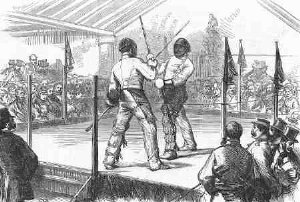 - Illustrated London News (26th March, 1870) |
| An appreciative audience watches a mixed-weapon display,
or possibly a competitive bout. The raised and roped-off stage is typical
of those erected for civilian Assaults of Arms, and is the ancestor of
modern boxing and professional wrestling rings. In this case, the artist
has probably omitted to draw the near posts and rope to allow us an unobstructed
view.
The player on the left, armed with what is probably a blunted steel sabre or military broadsword, performs a parry in seconde to deflect his opponent's bayonet thrust. Training bayonets were generally either wooden facsimile weapons, or old decommissioned rifles equipped with spring blades that would compress upon impact. Barely visible in this print is a blunt or padded ball affixed to the business end of the bayonet. Note the typical fencing whites, heavily padded helmet-masks and gauntlets worn by both players. The sabreur/broadswordsman is also wearing a cricket pad on his lead leg. General George McClellan's US Army bayonet fighting manual (1852) Rifle-bayonet fighting article A selection of 19th Century bayonet fencing images |
 |
| Eleven panels displaying a variety of gymnastic and combative feats.
First row, left: another interesting example of 19th century test cutting practice. The fencer uses a cavalry sabre to cut at what appear to be large chickens or turkeys suspended from an ingenious lever-arm contraption. For greater challenge, the poultry can be raised or lowered by an assistant leaning on the other end of the lever. A modern test-cutting event First row, right: in an example of mixed-weapon bouting, a sabre, broadsword or cane player is opposed by a bayonet fencer. General George McClellan's US Army bayonet fighting manual (1852) Second row: a dynamic series of pommel horse vaults. A brief history of the pommel horse in gymnastic training Third row: boxers clad in the typical shirts, knee-breeches, stockings and flat-soled shoes receive the judges' verdict, and are portrayed in sparring. Note the contrasting guard positions in the latter panel. Mid-19th century pugilism manuals Fourth row, left: two quarterstaff fencers engage. The sport of quarterstaffing was briefly revived in the late 19th century, employing heavy protective padding and relatively light staves of ash or bamboo. The distinctive leg protectors were adapted from cricket pads. Fourth row, right: a "physical culturist" at work, lifting a heavy club in the manner of Indian wrestlers. British colonisation of India led to the adoption of several traditional Indian exercises by the military, most notably club lifting and swinging. This drill became extremely popular in European and American exercise programs. Dick's Dumb-bell and Indian Club Exercises (1887) |
 Exercises in the Gymnasium (1874) |
| Clockwise, from top right; a display of club-lifting and swinging; Naval cutlass drill; a wrestling match (possibly in the Cumberland-Westmoreland style); gymnasts training on the horizontal bar. The boxers to the right in the central panel are in very unusual "reverse chancery"; the pugilist wearing the white hose has apparently caught his opponent in a headlock and is pummelling his opponent's face from behind his own back. Articles and on-line manuals dealing with 18th and 19th century boxing |
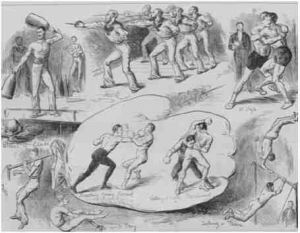 |
| The cutlass drill adopted for use by the 19th century British and American Navies represented a synthesis of broadsword (double-edged), backsword (single-edged), spadroon and singlestick techniques. It eventually developed into a cut and thrust system, employing wooden facsimile swords with basket hilts in partner training as demonstrated above, and steel weapons for drill training as seen here - |
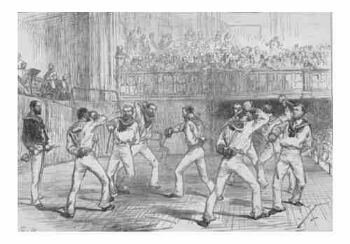 |
| A mid-19th century Naval cutlass manual online | 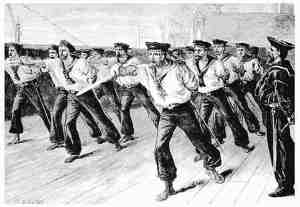 |
| First row, left - this appears to be a cutlass or cane fencing match. Note the cricket pad worn by the fencer on the left.
First row, right - this image is not distinct, but may represent a bout between two foilists. Second row, left - a montage of images portraying bayonet training, a procession of lance-bearing soldiers, and a trumpeter. Second row, right - a distinguished group of spectators. Third row, left - a boxing exhibition. Third row, right - a quarterstaff bout. The fencing masks and jacks, boxing gloves and cricket pads are typical of this sport. The final panel portrays a gymnast exercising on the horizontal bar. |
 |
| Top left - "the Science of the Foil". Note that each
fencer's left arm is bare, and the masks which enclose most of their heads.
Top right -"Bayonet v. Sword". Both combatants are wearing heavily padded gauntlets, though the sabreur's sword hand appears to be bare. The bayonet is tipped with a blunt for safety. Second row, left: "Sword v. sword, mounted". The fencers are probably using singlesticks. Second row, right: "Sponging off the Scars of Dishonour". An attendant uses a sponge and water to clean the vest of one of the fencers, while his opponent wheels his horse to face the audience. This may suggest that the singlesticks used in this competition were coated with a powder such as chalk, to denote the placement of strikes and cuts. Third row, left: "Slicing the Lemon". The cavalryman gallops past a series of stakes in the ground, each topped with a lemon which he must cut with one stroke of his sabre. This was a popular test of accuracy, featuring at many Assaults at Arms. Third row, right: "Tilting at the Ring". Another popular test, in which the rider must use his lance to pinion a series of small rings suspended from scaffolds. Fourth row, left: "Tent-pegging". This event, believed to have descended from an Indian feat-at-arms, involves spearing a series of small wooden pegs driven into the ground. This feat was employed by daring riders who would charge into hostile camps and literally spear out the tent-pegs, trapping their enemies inside the collapsing canopies. In the competitive version, maximum points were awarded for spearing and raising the peg intact, with fewer points for splitting the peg. Fourth row, right: "Annihilating the Turkish Forces". This is a complex steeplechase event involving leaping one's horse over barriers and "beheading" a series of wooden effigies in mid-leap. Note: the Tilting, Tent-pegging and Turk's Head events were sometimes combined into a kind of triathlon, with riders having to perform each skill in close succession. |
 - the Graphic (3rd July, 1880) |
| In this example of a mixed-weapons encounter, the cavalryman
on the left is employing a lance which is tipped with round blunts. His
opponent may be using a singlestick, wooden facsimile sword or a blunted
steel sword with a rounded-off point.
The rules for this type of competition forbade striking the horses, so players only attacked their opponents' helmets and upper bodies. This target restriction gave rise to the myth that cavalrymen chivalrously declined to strike below the waist in actual combat. A set of rules for competitive mounted combat was printed in the Official Sporting Rules Containing the Official Rules for Miscellaneous Games and Contests Not Scheduled in Other Numbers of Spalding's Athletic Library by the American Sports Publishing Co. (A.G. Spalding), 1909 |
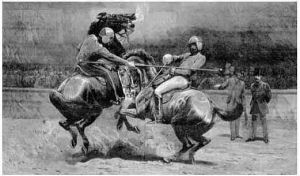
Tournament - Sword vs. Lance Men on Horseback (18th December, 1880) |
| The London-based fencing antiquarians Egerton Castle
and Captain Alfred Hutton, together with Sir Frederick Pollock, Captain
Carl Thimm and Colonel Cyril Matthey, were active researchers of ancient
swordplay, anticipating the present historical fencing movement by nearly
one hundred years. Among other goals, they sought to glean lessons from
historical fencing manuals that could be of use to Victorian soldiers.
Between 1891 and 1899 they performed a series of Assaults at Arms and lectures at venues including the Royal Lyceum Theatre, Oxford University and the Bartitsu Club gymnasium. First row, from the top, left - this is probably Sir Frederick Pollock, delivering his speech on historical swordplay First row centre - two fencers, likely Egerton Castle and Alfred Hutton, demonstrating the technique of the two-handed sword duel First row right, extending downwards - a selection of weapons including a two-handed sword, cup-hilt rapier, main gauche parrying dagger, transitional rapiers and smallswords Second row, left - a mixed-weapons encounter, rapier and buckler opposed to rapier and dagger. The fencer on the left appears to be parrying his opponent's thrust in carte with the edge of his buckler Second row, centre - detail of a smallsword hilt Second row, right - the fencer in the foreground appears to be employing a rapier/dagger combination to deflect his opponent's attack Third row, left - broadswords and a buckler Third row, centre - rapier/dagger opposed to rapier/cloak |
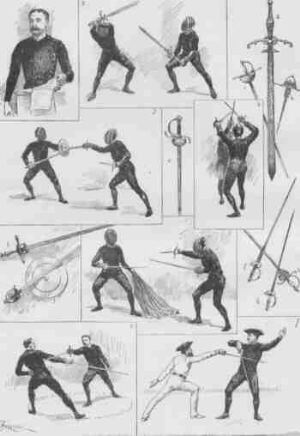 |
| A further demonstration of reconstructed antique fencing,
probably performed by Hutton and Castle.
Note the heavily padded fencing masks, dark tunics and knee-breeches worn by both players. The player on the left appears to be wearing an articulated steel gauntlet. Additional weapons including what may be rapiers, a helmet, and a cloak are visible resting on a bench in the background. |
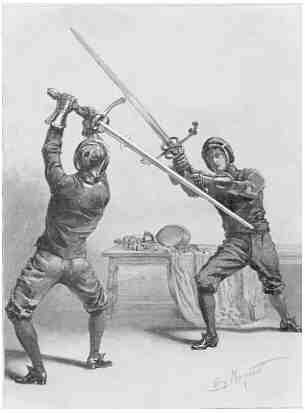 (14th April, 1894) |
| This print very likely represents an exhibition of sword
and buckler fencing performed for the Prince of Wales.
The dignified figure behind the lectern is probably Frederick Pollock, addressing the audience while Hutton and Castle fence. The fencer on the left appears to be wearing thigh pads, and all three men are clad in black fencing jacks, gauntlets, heavily padded masks, knee-breeches, stockings and flat-soled shoes or boots. Note the array of weapons leaning against the barrier rope in the foreground, including a selection of rapiers or cut-and-thrust swords and two great swords next to the lectern. Two tall lamps to either side of the display area appear to be arranged to cast light upon the demonstrators. |
 (28th March, 1891) |
| In the Balaclava Melee event, two teams of six helmeted riders armed with singlesticks attempted to knock the plumes from their opponent's helmets. The first team to be entirely de-plumed lost the match. |
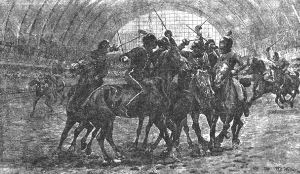 - Pictorial World (1886) |
| Mixed-weapons contests were extremely popular both with competitors and audiences. In this case, a mounted lancer is opposed by a bayonet fencer. The bayonetist's point has just been called by one of the three judges visible in the background, raising his baton to signify the successful thrust. As usual, both players are well-protected with almost full-head helmets, padded fencing vests and gauntlets with stiff leather vambraces (wrist and forearm guards). The bayonetist is also wearing a padded leather apron. The lance is made of bamboo, as were many of the staves used in quarterstaff fencing, and tipped with blunts at both ends. The bayonet "blade" is probably made of flexible baleen (whalebone), and is also tipped with a blunt. |
 (3rd June, 1893) |